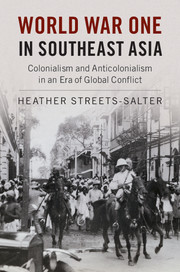Book contents
- Frontmatter
- Dedication
- Contents
- Acknowledgments
- List of Maps
- Maps
- Introduction
- 1 The Singapore Mutiny of 1915: Global Origins in a Global War
- 2 The Defeat of the Singapore Mutiny: Regional Expression of Global Alliances
- 3 Germans, Indians, and the War in the Dutch East Indies
- 4 The S.S. Maverick and the Unraveling of a Global Conspiracy
- 5 Siam and the Anti-Allied Conspiracies
- 6 China, Germany, and the Viet Nam Restoration Association
- Conclusion
- Select Bibliography
- Index
3 - Germans, Indians, and the War in the Dutch East Indies
Published online by Cambridge University Press: 06 April 2017
- Frontmatter
- Dedication
- Contents
- Acknowledgments
- List of Maps
- Maps
- Introduction
- 1 The Singapore Mutiny of 1915: Global Origins in a Global War
- 2 The Defeat of the Singapore Mutiny: Regional Expression of Global Alliances
- 3 Germans, Indians, and the War in the Dutch East Indies
- 4 The S.S. Maverick and the Unraveling of a Global Conspiracy
- 5 Siam and the Anti-Allied Conspiracies
- 6 China, Germany, and the Viet Nam Restoration Association
- Conclusion
- Select Bibliography
- Index
Summary
In August 1916, David Petrie, the newly appointed Special Officer for dealing with Indian sedition and German intrigues in the Far East, wrote that the British government had ample and “conclusive proof of the existence of…hostile intrigues” by enemy agents all over the region. Not only that, he argued they were being aided by “a number of revolutionary Indians who are still at large.” Most important, in his view, was “[t]he places which have served as the main bases for the prosecution of these conspiracies have been such neutral territories as America, Manila, the Dutch East Indies and Siam which, with the exception of the last, have afforded a safe asylum for the plotters. Certain places in China, notably Shanghai, have been similarly used.”
For all of the violence and drama surrounding the events of the Singapore mutiny in 1915, it was only one manifestation of the ways the war made itself felt in the region. When we zoom out to explore the rest of the region between 1914 and 1918, it is clear that the circumstances of the war influenced not only all of the colonies associated with a belligerent state but also those states and colonies that chose to remain neutral. In fact, as Petrie argued, much of the activity surrounding the attempts by Germany and its allies to disrupt colonial rule in the region took place on neutral territory, just outside Allied reach. From these neutral territories, individuals working on behalf of Germans and their anticolonial allies produced and distributed propaganda, arranged shipments of arms, incited unrest in enemy territory, and aided German ships in the area. At the same time, representatives of the Allied powers fought back by strengthening their networks of communication and information in order to foil those who would use neutral territory as their base.
This chapter and Chapters 4–6 demonstrate that neutral territories in Southeast and East Asia were critical to the struggle between Central and Allied powers in the region during the Great War. In this respect they explore mostly uncharted historiographical terrain. Although several important works have investigated schemes by the Central Powers to foment rebellion in Allied colonial territory, these have mostly focused on Central Asia, North America, or on the German–Ottoman relationship, either ignoring or glossing over East and Southeast Asia.
- Type
- Chapter
- Information
- World War One in Southeast AsiaColonialism and Anticolonialism in an Era of Global Conflict, pp. 88 - 110Publisher: Cambridge University PressPrint publication year: 2017



